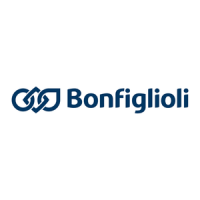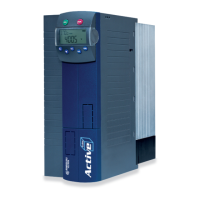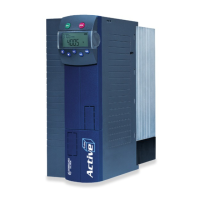
Do you have a question about the BONFIGLIOLI ACTIVE Cube ACU 401-23 and is the answer not in the manual?
| Brand | BONFIGLIOLI |
|---|---|
| Model | ACTIVE Cube ACU 401-23 |
| Category | Inverter |
| Language | English |
Specifies the intended purpose and compliance of the frequency inverter with relevant directives.
Details prohibited uses of the frequency inverter and the manufacturer's liability.
States that the device is IP 20 and not permitted for use in explosive atmospheres.
Identifies potential hazards like electrical, electrostatic, and thermal risks not eliminated by design.
Instructions on complying with and not removing safety information and warnings on the inverter.
Defines hazard classes, symbols for general hazards, electrical voltage, prohibition signs, and personal safety equipment.
Operator responsibilities including ensuring safety regulations and applicable laws are followed.
Defines responsibilities for staff selection, qualification, and general work safety procedures.
Provides safety instructions for the STO function, emphasizing proper installation and commissioning.
Details technical specifications for control terminals X210A and X210B, including digital and analog signals.
Details mounting dimensions and possibilities for ACU 201/401 inverters up to 3.0/4.0 kW.
Details mounting dimensions and possibilities for ACU 201/401 inverters in the specified power range.
Details mounting dimensions and possibilities for ACU 401 inverters in the specified power range.
Details mounting dimensions and possibilities for ACU 401 inverters in the specified power range.
Details mounting dimensions and possibilities for ACU 401 inverters in the specified power range.
Provides measures for ensuring electromagnetic compatibility (EMI) during installation.
Details conductor cross-section dimensioning and typical cross-sections for various connections.
Provides instructions and safety warnings for connecting the frequency inverter to the mains supply.
Provides instructions and safety warnings for connecting the motor and brake resistor to the inverter.
Details connection procedures and dimensioning for brake resistors, including safety precautions.
Illustrates mains connections for ACU 201 and 401 inverters across different power ratings and configurations.
Describes the assignment and configuration of control terminals for various software functions.
Describes functions for variable-speed control of 3-phase machines in standard applications.
Extends sensorless control with a Technology Controller for flow, pressure, level, or speed control.
Provides functions for sensorless, field-oriented control of 3-phase machines with current/voltage data.
Extends sensorless FOC control with a Technology Controller for parameter-based control.
Extends sensorless FOC control with torque control, enabling jerk-free switch-over.
Offers speed-controlled, field-oriented control with speed sensor feedback for precise performance.
Extends speed-controlled FOC with a Technology Controller for parameter-based control.
Extends FOC control with torque-dependent control, allowing jerk-free switch-over.
Provides speed-controlled, field-oriented control of synchronous machines with speed sensor feedback.
Extends synchronous FOC control with torque control, enabling jerk-free switch-over.
Offers speed-controlled, field-oriented control of synchronous machines without resolver feedback.
Extends sensorless FOC control with a Technology Controller for parameter-based control.
Extends sensorless FOC control with torque control, enabling jerk-free switch-over.
Describes the function for copying parameter values between the control unit and the frequency inverter.
Explains how to prepare and perform parameter transmission from the control unit to the frequency inverter.
Safety precautions and checks required before switching on the mains voltage.
Guides the user through the guided commissioning process for parameter settings.
Explains how Parameter Configuration 30 determines control inputs, outputs, and software functions.
Instructions for setting rated motor parameters from the rating plate or data sheet.
Describes how to parameterize the 3-phase machine starting behavior, including flux formation.
Defines the stopping behavior of the 3-phase machine using Operation mode 630.
Details admissible load behavior and parameters for warning limits related to overload.
Explains temperature monitoring and warning limits for heat sink and inside temperatures.
Details configuration of control terminals for motor temperature monitoring.
Explains how to control the motor using the control unit keys, limited by ramp parameters.
Sets current limits to avoid inadmissible load and prevent fault switch-off.
Monitors DC link voltage and controls it to set limit values, bridging short-term power failures.
Provides PID control for applications like pressure, volume flow, or speed control.
Explains the two current controllers for controlling flux-forming and torque-forming current components.
Enables torque control alternative to speed control, usable above Frequency Limit 624.
Describes selecting the actual speed value source and operation modes for the speed controller.
Controls flux-forming current component, optimizing parameters via machine model.
Automatically adapts output frequency to machine behavior in basic speed and field weakening areas.
Details the brake chopper transistor and external brake resistor connection.
Describes monitoring mechanisms for recognizing thermal overload to prevent motor damage.
Explains the use of motor protection switches for disconnecting the motor from power supply upon overload.
Details control functions for adapted implementation of generator energy into heat.
Explains the motor chopper function for adapted implementation of generator energy.
Lists actual values of the machine and frequency inverter, organized by category.
Provides a comprehensive list of parameters organized by menu branches for configuration.











